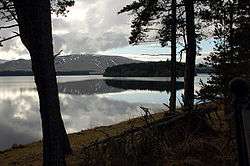Gladhouse Reservoir
Gladhouse Reservoir, formerly known as Moorfoot Loch, is a reservoir in Midlothian, Scotland, five miles (8 km) south of Penicuik. It is the most southerly reservoir in Midlothian, as well as being the largest area of freshwater in the Lothians. It is used to supply Edinburgh with drinking water.
| Gladhouse Reservoir | |
|---|---|
 | |
| Location | Midlothian |
| Coordinates | 55.7695°N 3.1198°W |
| Type | reservoir |
| Basin countries | Scotland |
| Surface area | 460 acres (190 ha) |
| Islands | 3 |
| Designated | 14 July 1988 |
| Reference no. | 404[1] |
History
It was created in 1879 by the engineer James Leslie (1801–1889)[2] and is the oldest of the reservoirs built in the catchment of the River South Esk. It was constructed to supply Edinburgh with water, the older and smaller reservoirs in the Pentland Hills being unable to meet the city's needs.[3]
Description
Gladhouse Reservoir covers an area of 186 hectares (460 acres) meaning it is the largest freshwater area in the Lothians.[4] It is a sizeable, rather shallow waterbody which contains two small islands, lying at an altitude of 270 metres (890 ft) above sea level at the foot of the Moorfoot Hills.[5] The dam and associated construction were made out of pink sandstone and was designed to contain up to "1700 million gallons". At the time this was regarded as a notable feat of engineering. In damming the River South Esk to create the reservoir the people of Edinburgh increased their available supply by 180 litres (40 imp gal) per person.[6] It is the most southerly of all the reservoirs in the Lothians.[3]
Fishing
Gladhouse Reservoir is stocked with brown trout and is a popular site for fishing.[3]
Wildlife interest
Gladhouse Reservoir is an important roost site for wintering populations of pink-footed goose and has a large population of greylag goose. It has been designated a Ramsar Site because of its internationally important counts of pink-footed goose.[7] Mallard, tufted duck, teal, coot, common moorhen, great crested grebe and little grebe have all bred. In winter there are populations of mallard, teal, wigeon and tufted duck.[5]
See also
- Edgelaw Reservoir
- Glencorse Reservoir
- List of reservoirs and dams in the United Kingdom
References
- "Gladhouse Reservoir". Ramsar Sites Information Service. Retrieved 25 April 2018.
- "James Leslie". scottisharchitects.org.uk. Retrieved 5 March 2020.
- "Gladhouse Reservoir". Gazetteer for Scotland. Retrieved 3 March 2020.
- "Gladhouse". Esk Valley Trust. Retrieved 3 March 2020.
- "GLADHOUSE RESERVOIR Site of Special Scientific Interest SITE MANAGEMENT STATEMENT". Scottish Natural Heritage. Retrieved 3 March 2020.
- "GLADHOUSE RESERVOIR INCLUDING DAM, WEIRS, REVETMENTS, GANGWAY, MEASURING HOUSE, TWEEDALEBURN AQUEDUCT AND BRIDGES OVER TRIBUTARIES". Historical Environment Scotland. Retrieved 3 March 2020.
- "Gladhouse Reservoir RAMSAR". Scottish Natural Heritage. Retrieved 3 March 2020.
External links
| Wikimedia Commons has media related to Gladhouse Reservoir. |